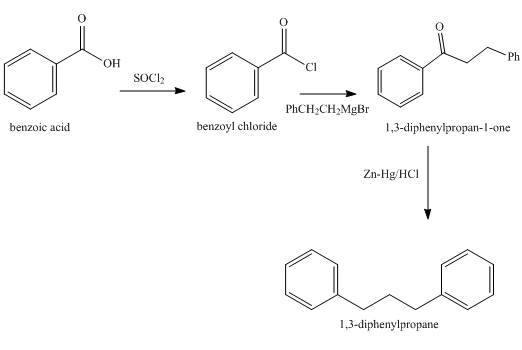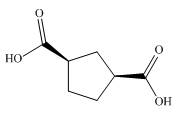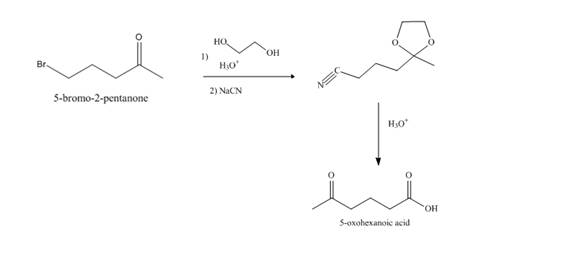
(a)
Interpretation:
Synthesis of
Concept introduction:
Synthesis is the process of conversion of one compound into another using reagents. For the conversion of one compound into another, multiple number of steps undergoes using multiple reagents.
Answer to Problem 20.47AP
Synthesis of

Explanation of Solution
The synthesis of

Figure 1
The total number of steps in the synthesis are five. In the first step propanoic acid is converted into acid chloride which is converted into
The ketone
Synthesis of
(b)
Interpretation:
Synthesis of the given compound from allyl alcohol using appropriate reagents is to be stated.
Concept introduction:
Synthesis is the process of conversion of one compound into another using reagents. For the conversion of one compound into another, the multiple numbers of steps undergo using multiple reagents.
Answer to Problem 20.47AP
Synthesis of the given compound from allyl alcohol using appropriate reagents is shown below.

Explanation of Solution
The given compound to be synthesized is shown below.

Figure 2
The synthesis of the given compound from allyl alcohol is done using multiple steps shown below.

Figure 3
The allyl alcohol,
Synthesis of the given compound from allyl alcohol using appropriate reagents is shown in Figure 3.
(c)
Interpretation:
Synthesis of
Concept introduction:
Synthesis is the process of conversion of one compound into another using reagents. For the conversion of one compound into another, the multiple numbers of steps undergo using multiple reagents.
Answer to Problem 20.47AP
Synthesis of

Explanation of Solution
The synthesis of

Figure 4
The conversion of pentanoic acid to acid chloride is done by using thionyl chloride. The acid chloride thus produced is reacted with DIBAH at
Synthesis of
(d)
Interpretation:
Synthesis of
Concept introduction:
Synthesis is the process of conversion of one compound into another using reagents. For the conversion of one compound into another, the multiple numbers of steps undergo using multiple reagents.
Answer to Problem 20.47AP
Synthesis of

Explanation of Solution
The synthesis of

Figure 5
Toluene is first oxidized using potassium permanganate to give benzoic acid. A carboxylic acid group is a meta-directing group. The benzoic acid is then nitrated to give
Synthesis of
(e)
Interpretation:
Synthesis of
Concept introduction:
Synthesis is the process of conversion of one compound into another using reagents. For the conversion of one compound into another, the multiple numbers of steps undergo using multiple reagents.
Answer to Problem 20.47AP
Synthesis of

Explanation of Solution
The synthesis of

Figure 6
Benzoic acid is converted into benzoyl chloride in the first step which is then reacted with Grignard’s reagent to give an appropriate ketone which on Clemmensen reduction gives the required product
Synthesis of
(f)
Interpretation:
Synthesis of given
Concept introduction:
Synthesis is the process of conversion of one compound into another using reagents. For the conversion of one compound into another, the multiple numbers of steps undergo using multiple reagents.
Answer to Problem 20.47AP
Synthesis of given

Explanation of Solution
The synthesized compound is

Figure 7
Synthesis of given

Figure 8
The
Synthesis of given
(g)
Interpretation:
Synthesis of given dicarboxylic acid from norbornene using appropriate reagents is to be stated.
Concept introduction:
Synthesis is the process of conversion of one compound into another using reagents. For the conversion of one compound into another, the multiple numbers of steps undergo using multiple reagents.
Answer to Problem 20.47AP
Synthesis of given dicarboxylic acid from norbornene using appropriate reagents is shown below.

Explanation of Solution
The given dicarboxylic acid is shown below.

Figure 9
Synthesis of given dicarboxylic acid from norbornene using appropriate reagents is done in a single step shown below.

Figure 10
The conversion of norbornene into the required dicarboxylic acid is done in a single reaction. The ozonolysis of norbornene with oxidative work gives the required product.
Synthesis of given dicarboxylic acid from norbornene using appropriate reagents is shown in Figure 10.
(h)
Interpretation:
Synthesis of
Concept introduction:
Synthesis is the process of conversion of one compound into another using reagents. For the conversion of one compound into another, the multiple numbers of steps undergo using multiple reagents.
Answer to Problem 20.47AP
Synthesis of

Explanation of Solution
Synthesis of

Figure 11
The compound,
Synthesis of
(i)
Interpretation:
Synthesis of
Concept introduction:
Synthesis is the process of conversion of one compound into another using reagents. For the conversion of one compound into another, the multiple numbers of steps undergo using multiple reagents.
Answer to Problem 20.47AP
Synthesis of

Explanation of Solution
Synthesis of

Figure 12
The compound,
Synthesis of
Want to see more full solutions like this?
Chapter 20 Solutions
EBK ORGANIC CHEMISTRY
- 19) Which metal is most commonly used in galvanization to protect steel structures from oxidation? Lead a. b. Tin C. Nickel d. Zinc 20) The following molecule is an example of a: R₁ R2- -N-R3 a. Secondary amine b. Secondary amide c. Tertiary amine d. Tertiary amidearrow_forwardpls helparrow_forwardIndicate the product of the reaction OH OH CH3-CC- Ph + H2SO4 a 20°C | CH3 Pharrow_forward
- 35) Complete the following equation by drawing the line the structure of the products that are formed. Please note that in some cases more than one product is possible. You must draw all possible products to recive full marks! a. ethanol + 2-propanol + H2SO4 → b. OH conc. H2SO4 CH2 H3C CH + K2Cr2O7 C. d. H3C A pressure CH3 + H2 CH Pt catalystarrow_forward21) The rate of reaction depends upon: a. the concentration and nature of reactants b. the temperature of the reaction C. whether or not a catalyst was used d. all of the above 22) A Maxwell-Boltzmann curve shows the distribution of molecular energies in a reaction system. When the temperature in this system is increased, the peak is a. higher and further to the right. b. higher and further to the left. c. lower and further to the right. d. lower and further to the left. 23) Which of the following correctly describes the reaction represented by the reaction below? CaCO3 (s) + energy → CaO (s) + CO2 (g) a. It is exothermic and the potential energy is greater in the reactants than the products. b. c. It is exothermic and the potential energy is greater in the products than the reactants. It is endothermic and the potential energy is greater in the products than the reactants. d. It is endothermic and the potential energy is equal for the products and reactants.arrow_forwardpls helparrow_forward
- 27) Draw the energy level diagram and write the full and shorthand electron configuration for a neutral sulfur atom.arrow_forwardIndicate whether these compounds are isomers, enantiomers, or tautomers. OCH OCH محمد ممدarrow_forward30) Substance A to E below are listed with several of their properties. The identities of the substances are identified in random order below: Iron, ethane, ethanol, sodium nitrate, graphite First classify each substance as either a polar covalent compound, non-polar covalent compound, ionic compound, metallic solid, or network solid. Write your predictions in the sixth coloumn of the chart, under "type of substance." Then, identify the identity of the substance in the last coloumn. Substance Melting Point Boiling Point Solubility in H₂O Electrical Conductivity Type of Substance Identity of Substance (°C) (°C) as: Solid, Liquids, Solution A -182 -88 Insoluble No/No/- B 1538 2862 Insoluble Yes/Yes/- C 308 380 Soluble Yes/Yes/Yes Ꭰ 3456 Insoluble No/-/- E -114 78 Soluble No/No/Noarrow_forward
